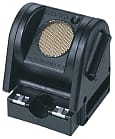
- Temperature Probe
The temperature probe that comes with the data analyzer uses a thermistor to measure the temperature of liquids. Changes in the temperature of thethermistor causes a corresponding change in its resistance, which is then converted to a temperature value.

- Voltage Probe
The voltage probe that comes with the data analyzer can be used to read a voltage in the range of ±10 Volts. This probe is designed with Auto-ID resist-ance, so connecting it to the data analyzer automatically switches to voltage sampling. The black probe should be connected to ground, while the red probe should be connected to signal voltage.

- Light Probe
The light probe that comes with the data analyzer uses a photosensitive element called a Cds to measure brightness, which is then converted to a numeric value. The value produced does not correspond to any standard unit of measurement, but simply indicates a relative measure of brightness in the range of 100 to 999.

 Motion Detector : EA-2 (Option)
Motion Detector : EA-2 (Option)EA-2 is a sonar ranging device with a sensing range of 0.6 to about 8 meters.The EA-2 emits ultrasonic pulses and detects pulses returned as echoes from the target. It can be connected to the CASIO EA-100 Data Analyzer to accumulate and analyze data.
- Barometer
- Conductivity Probe
- Dissolved Oxygen Probe
- Gas Pressure Sensor
The EA-200/100 are designed and engineered for educational purposes only. Use of the EA-200/100 for any non-educational testing or processing is not recommended.
The Saltire Sensors mentioned above have been tested using experiments commonly performed in educational applications. However, operation cannot be guaranteed for all sampling conditions, accuracy, sampling ranges, etc.
Attention users of the E-CON2 Ver1.0 add-in application for the ALGEBRA FX Series and GRAPH 100
When using a probe that requires warm-up, be sure to specify a Warm-up Time setting that is greater than the Sampling Interval setting. This helps to obtain more stable measurements.
Important!
Warm-up is not possible in the Extended Sampling mode (EA-200).
·Available sensor list of Saltire as of June 2004
Vernier Software & Technology http://www.vernier.com/
- Low-g Accelerometer (LGA-BTA)
- Gas Pressure Sensor (GPS-BTA)
- 25-g Accelerometer (ACC-BTA)
- Magnetic Field Sensor (MG-BTA)
- 3-Axis Accelerometer (3D-BTA)
- Microphone(*1) (MCA-BTA)
- Barometer (BAR-BTA)
- pH Sensor (PH-BTA)
- CO2 Gas Sensor (CO2-BTA)
- Relative Humidity Sensor (RH-BTA)
- Colorimeter (COL-BTA)
- Thermocouple (TCA-BTA)
- Conductivity Probe (CON-BTA)
- Vernier Photogate (VPG-BTD)
- Dissolved Oxygen Probe (DO-BTA)
- Dual-Range Force Sensor (DFS-BTA)
- EKG Sensor (EKG-BTA)
The EA-200/100 are designed and engineered for educational purposes only. Use of the EA-200/100 for any non-educational testing or processing is not recommended.
The EA-200/100 are designed and engineered for educational purposes only.
Use of the EA-200/100 for any non-educational testing or processing is not recommended.
The Vernier Sensors mentioned above have been tested using experiments commonly performed in educational applications.
However, operation cannot be guaranteed for all sampling conditions, accuracy, sampling ranges, etc.
For detailed information on the sensor (accuracy, sampling ranges, etc.), visit the Vernier Website.
(*1)When using the EA-100, up to 10 samples can be taken of one period of a 100Hz sound.
When using the EA-200, up to 500 samples can be taken of one period of a 100Hz sound.
Attention users of the E-CON2 Ver1.0 add-in application for the ALGEBRA FX Series and GRAPH 100
When using a probe that requires warm-up, be sure to specify a Warm-up Time setting that is greater than the Sampling Interval setting.This helps to obtain more stable measurements.
Important!
Warm-up is not possible in the Extended Sampling mode (EA-200).
·Available sensor list of Vernier as of May 2011
